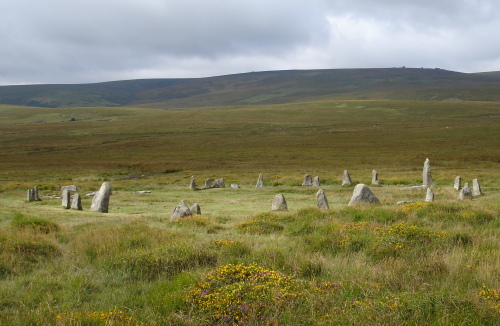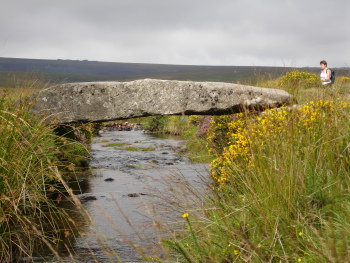On Gidleigh Common at a short distance above the North Teign near its confluence with its
tributary the Wallabrook stand the remains of what Rowe describes as by far the finest
example of this rude kind of relic in Devonshire [Rowe, p90]. It is unique
among the many stone circles on the moor in that it has not undergone restoration, despite
having had several stones despoiled and others impaired. In the words of Worth, it has
suffered much spoliation, but has been spared from the hand of the restorer [Worth,
p248].
The precise purpose of such a wide stone circle has eluded antiquarians. Indications that
large fires were lit at the centre have been noted with no convincing explanation offered
for these conflagrations. William Crossing chose the adjective sepulchral to characterise
such circles, though no evidence of burials within their circumference has been identified.
Though formerly looked upon as temples, they are now known to be sepulchral in their
origin.....the stones composing the sepulchral circle stand at some distance from each
other, and in the finer examples are several feet in height. The largest sepulchral circle
on Dartmoor is that at Scorhill [Crossing, p35].
More recent authorities reserve judgement as to the circle's intended function. In
particularly Worth, who has made a detailed study of the Scorhill circle, is non-committal,
choosing simply to differentiate it from other circular constructions whose purpose is
evident:
To avoid all suggestion of knowledge which is not ours, we have taken the trivial name
'stone circle', and applied it as a specific name to those circles of stone which are
neither huts, retaining circles, nor pounds. [Worth, p248]
Nineteenth century antiquarians have specified various figures for the number of stones
still standing, those that have fallen, and the number that would be required to complete the
Scorhill stone circle. These discrepancies don't show a progressive loss of standing stones
which could be accounted for by robbery or collapse, prompting Worth to comment
It is traditional of certain groups elsewhere in Britain that no two counts can be made to
agree, a tradition which may be better founded that I had heretofore credited. [Worth,
p249]
The third edition of Rowe's Perambulation revised by his nephew J Brooking Rowe
comes close to Worth's own estimate of the number of upright and fallen stones made in
1932:
The two principal columnar masses in this peristyle stand at nearly opposite points of the circle; the
highest, which in its widest part is about thirty inches, rising nearly eight feet from the
surface and the other standing upwards of six feet. The lowest are about three feet high;
eight stones lie on the ground and twenty-four of these time worn obelisks still maintain
their erect position, and twenty stones would be required to fill up the vacancies.
[Rowe, p90]
Worth counts one fewer upright and also one fewer fallen, but assays that a total of 65-70
would be needed to complete the ring.
This account of the stones in the circle that have been despoiled or vandalised is
provided by Worth.
..it is locally recognized that other original members of the monument have found
utilitarian use not far away. There is a pot-water leat to Scorhill and other farms
which contours the hillside to the west and south of the circle, and at its nearest is less
than 60yd distant. Here it crosses a mire, and it has been found difficult to maintain its
lower bank, with the result that the circle has at some time been raided to provide stones
to retain the water. The stones are all columnar, and beyond doubt the local view that they
came from the circle is correct.
In addition to this direct robbery, three of the fallen stones yet remaining at the circle
have been attacked; one lying outside has been shortened, by how much cannot be said, but
its original length must have exceeded 6ft; two have been holed for splitting
longitudinally, off one a piece has been taken, and the other has also been trimmed. The
perpetrator of these last outrages was caught in the act, his desire was for gate-posts,
but he had to obtain them elsewhere. [Worth, p252]
Leaving the stone circle and following the gentle slope down to the Wallabrook, you will
find that it can be crossed by a sturdy clapper bridge spanning the stream.
Our course now leads to the Wallabrook, which flows at the foot of Scorhill Down. The means
of crossing is afforded by one of the primitive bridges, of which we have so many examples
on the Moor, consisting of a single slab of ponderous granite, fifteen feet long, nearly
three wide, and twenty inches thick. [Rowe, p90]
Worth's Dartmoor by R Hansford Worth, David & Charles, 1967.

